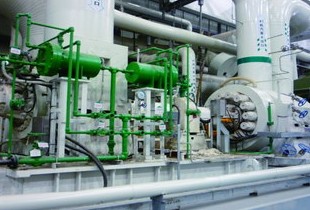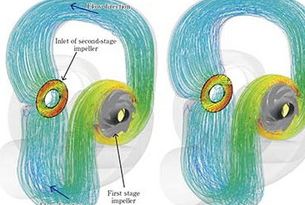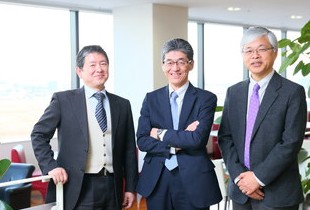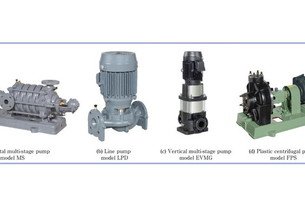Issue No. 254〔Technical Papers〕
Pretreatment with a Foam Fractionator for the Sea Water Reverse Osmosis (SWRO) Desalination Process
Author
Kazuaki SHIMAMURA*
Ryosuke HATA*
Masuhiro HAYASHI*
Ichiro TSUNODA**
Claudius E. Wendianto**
Paul Somadjaja**
- *
Swing Corporation
- **
PT. Beta Pramesti Asia
For the seawater desalination facilities based on reverse osmosis (RO), the pretreatment technologies, such as sand filtration and UF filtration, is essential to maintain the performance of RO membranes. To ensure the stable performance of the solidliquid separators as pretreatment processes, prior to them, a foam fractionator is proposed to firstly remove turbid components, transparent exopolymer particles (TEP), and biopolymers, and its performance was reported in this paper. In labscale experiments, we have verified the performance of the foam fractionator and studied the effect of TEP on the treatment performance of RO membranes. We also conducted pilot-scale experiments to verify the effectiveness of the foam fractionator during long-term continuous operations carried out both in Tokyo, Japan, and in Jakarta, Indonesia.
Keywords: Foam Fractionator, Pretreatment, Transparent Exopolymer Particles (TEP), Biopolymers, Seawater desalination, Fouling, Reverse osmosis, Sand filter, Ultrafiltration, Turbidity
1. Introduction
Seawater desalination is believed to be one of solutions for the challenge of global water scarce. Seawater reverse osmosis (SWRO) has been employed widely as one of desalination technologies, since it can effectively reduce energy consumption and operational cost compared to the conventional evaporation process. However, membrane fouling of SWRO is an increasing challenge for the relatively contaminated seawater, which results in the decrease of permeability and the increase of operating pressure. To address this issue, in addition to the conventional coagulation and sand filtration process, ultrafiltration (UF) itself or UF combined with dissolved air flotation (DAF) was employed as the more advanced pretreatment processes recently. When the seawater pollution becomes severe, more operational issues in these pretreatment processes arise, such as the increase of filtration resistance and sludge amount, the higher possibility of sludge leakage into treated water.Substances that may contribute to the pollution load include particulate matter, such as sand, mud, microorganisms (algae, carcasses, and excretion), flocculants used in pretreatment, and dissolved organic matter, such as proteins, humic substances, and polysaccharide (metabolites) derived from seawater. It is reported that the fast increase of trans-membrane pressure (TMP) of UF membrane, or the fast RO membrane fouling without effective removal during the pretreatment by the sand filtration or DAF, happened caused by the high concentration of organic pollutants, particularly for the transparent exopolymer particles (TEP) from phytoplankton and bacteria, or for the biopolymers, the dissolved organic matter that could be detected by liquid chromatography-organic carbon detection (LC-OCD)1)-3).Therefore, the effect of these organic substances on the treatment performance of RO membranes was quantitatively evaluated by the labscale experiments firstly. In order to enhance the pretreatment of seawater desalination, the incorporation of a foam fractionator before the conventional pretreatment processes was proposed, and the removal effect on the organic substances that caused membrane fouling was investigated. This paper reported the results in the lab-scale experiments to evaluate the performance of the foam fractionator, and in the pilot-scale experiments to verify its effectiveness during long-term operations carried out in Jakarta, Indonesia and in Tokyo, Japan, with a foam fractionator prior to the sand filtration.
2. Material and methods
2.1 Effects of foulants on the performance of RO membrane
The effect of organic foulants on the performance of RO filtration was investigated by the lab-scale filtration experiments. The experiments were conducted by measuring the permeability of RO membrane quantitatively using the seawater added with xanthan gum (XG) as the TEP source.Figure 1 shows the labscale experimental equipment. 20 L seawater, after filtration with UF membrane and addition with the XG of 0 – 1200 mg, was used as the raw water. The RO filtration was operated with the raw water flow rate of 5.5 L/min and operational pressure of 5.0 MPa. Both permeate water and concentrated water were returned to the raw water tank and circulated continuously. The permeability of RO membrane was calculated by the permeate flux and operational pressure measured after 1-day continuous operation since the addition of XG. The corresponding permeability was obtained for the different addition amount of XG.

Fig. 1 Laboratory Test Equipment
2.2 Lab-scale experiments to verify the performance of foam fractionator
(1) The foam fractionator
Figure 2 shows an image diagram of the foam fractionator. With the simple structure, the fractionator consists of a raw-water supply pipe, an effluent pipe, an air supply pipe, and a discharge pipe for generated foam. As for the basic removal mechanisms, as shown in Figure 3, the hydrophobic organic substances could adhere to the surface of foam, and separate and discharge out together with the foam from the upper part of the fractionator after the concentration. The foam fractionator offers the advantages of the low cost of equipment, the small footprint and space savings because the contact time is as short as 1.5 to 3 minutes. The effluent of the foam fractionator was then treated with a solid-liquid separator (a sand- or membranebased filter) and then supplied to RO membranes.

Fig. 2 Image Diagram of the Foam Fractionator

Fig. 3 How Turbid Substances are Removed
(2) Experimental methods
The performance of the foam fractionator was evaluated by the lab-scale experiments (Figure 4), according to the removal rates of turbidity and organic foulants, using TEP and biopolymer as the indicator. The seawater from Tokyo Bay was used as the raw water.
The detailed experimental procedures are described as follows.
- (i)
Add 1.9 L of seawater to the foam fractionator.
- (ii)
Arrange the fractionator with the foam separator, air stone, etc.
- (iii)
Aerate 1 to 4 minutes.
- (iv)
Collect water samples together with foam from the upper part of the fractionator
- (v)
Stop the operation after designated time.
- (vi)
Measure the volume of the residual liquid inside the fractionator, and take samples as the treated water
- (vii)
Analyze the samples.

Fig. 4 Foam Fractionator
(3) Analytical methods
Total organic carbon (TOC) is typical indicator for the organic substances. However, only a part of organic components are strongly correlated to the membrane fouling. As mentioned above, TEP and biopolymer were measured as the indicator of organic since they contribute to membrane fouling mainly. The measurement method for TEP has been proposed by Passow et al.4) and the amount of TEP is defined as the concentration of mucopolysaccharides stained with aqueous solution of alcian blue. The measurement method is simply described as below (according to the method proposed by Passow et al., and partially modified).
- (i)
The sample water is suction-filtered (less than 20 kPa) using polycarbonate paper (PC paper) with a pore size of 0.4μm.
- (ii)
Residue on the PC paper is rinsed by pure water with the suction-filtration.
- (iii)
The alcian blue solution is added to the filter to partially stain the residue.
- (iv)
Residue is rinsed again by pure water with the suction-filtration.
- (v)
The PC paper is removed from the filtration apparatus and then soaked in the 10 mL solution of 80 % (wt) sulfuric acid.
- (vi)
The PC paper is kept soaking in the solution for 2 hours, and then the absorbance of the supernatant at the wavelength of 787 nm is measured.
- (vii)
The concentration of TEP is quantitated by the calibration curve using the standard solution of xanthan gum. The residue is indicated as the concentration of xanthan gum (mg-XG/L).
Biopolymers are measured by LC-OCD, where the organic components in samples are fractionated by the size exclusion chromatography, and the concentration of each component is determined by the organic carbon detector (OCD), UV-detector (UVD), and organic nitrogen detector (OND). The soluble organic substances in water samples can be fractionated into biopolymers, building blocks, humic-like substances, low molecular weight (LMW) acids, and LMW neutrals. The organic carbon concentration and the other characteristics of each organic component can be quantitatively assessed by using OCD, UVD, and OND. It was reported that the organic substances classified as biopolymers by LC-OCD had the strong correlation to the membrane fouling5) .
2.3 Pilot-scale experiments to verify the performance of foam fractionation
The pilot-scale experiments were carried out in Jakarta, Indonesia to verify its effectiveness and in Tokyo, Japan to confirm its enhancement effect on the conventional pretreatment process by the combination of foam fractionator with coagulation and sand filtration process.
(1) Pilot-scale evaluation in Indonesia
In the Ancol seawater desalination facilities in Indonesia, the seawater quality significantly fluctuates. A pilot experimental device of foam fractionation was installed to verify its removal performance.
The outline of Ancol seawater desalination plant is described as below.
- Location
: Jakarta city
- Plant configuration
: Water intake, DAF, UF, and RO
- Desalination capacity
: 4500 m3 /day
Figure 5 shows the flow of desalination treatment process. Seawater taken from the seawater storage tank was fed into the foam fractionator to examine its removal performance. Table 1 shows the operational conditions. The contact time was 2.1 - 3.8 minutes, and the flow rate of seawater was 1.2 - 2.2 m3 /h, accounting for 0.5 % of the flow rate in main stream, and thus almost no impact on plant operation.

Fig. 5 Test Flow in the Ancol Seawater Desalination Plant
| Conditions | |||
| Foam fractionator | Treatemnt capacity | m3/h | 1.2 to 2.2 |
| Contact time | min | 2.1 to 3.8 | |
(2) Combination of foam fractionator with sand filtration in a pilot system in Japan
The pilot experimental system (Figure 6) was constructed in the Sodegaura Plant of Ebara Corporation to compare the pretreatment performance with and without foam fractionator combined with sand filtration during continuous operation using seawater from Tokyo Bay. The foam fractionator was placed after coagulation and before sand filtration in Line 2, while only conventional pretreatment by the coagulation and sand filtration was adopted as the reference in Line 1.Table 2 shows the operational conditions for both lines. The foam fractionator in the Line 2 was operated with the flow rate of 2.3 m3 /h and the contact time of 2.0 minutes. For the comparison, both lines were operated under the same conditions for the sand filtration and RO filtration.

Fig. 6 Continuous Treatment Flow
| Line 1 | Line 2 | |||
| Foam fractionator | Treatemnt capacity | m3/h | Not used | 2.3 |
| Contact time | min | 2.0 | ||
| Sand filtration | Filtration method | − | Gravity-type DMF | Gravity-type DMF |
| Filtration rate | m/d | 177 | 177 | |
| RO Membrane | Specs | − | Polyamide | Polyamide |
| Spiral RO membrane | Spiral RO membrane | |||
| Operation method | − | Constant control of permeated water amount | Constant control of permeated water amount | |
3. Results and discussion
3.1 Effects of foulants on the performance of RO membrane
Figure 7 shows the relationship between water permeability of RO membrane and XG addition amount in lab-scale experiments. It was clearly shown that the water permeability decreased with the increase of XG addition amount. The water permeability was 5.1×10−9 m/(s·kPa) with XG addition amount of 750 mg, approximately 87 % of the initial water permeability without XG addition, while 4.8×10−9 m/(s·kPa) with XG addition amount of 1200 mg, approximately 77 % of the initial value. It was supposed that the decrease of water permeability was caused by the concentration polarization and followed attachment of organic substances counted as TEP on the surface of RO membrane.The concentration polarization resulted to the decrease of effective pressure (the inlet pressure minus the pressure loss and the essential osmotic pressure), which substantially acted as the driving force for RO filtration, while the attachment of TEP, i.e., the formation of membrane fouling, increased the filtration resistance and decreased the flux. With the increase of XG attachment amount, the concentration polarization was further increased, and thus decreased the effective pressure and resulted in further decrease in water permeability. In our previous study1), the TEP concentration in the feed water was found to be positively correlated to the development of membrane fouling for the RO system using actual seawater, which is coincident with the results obtained in this study.

Fig. 7 Relationship between the Amount of Added XG and Water Permeability Coefficient
3.2 Lab-scale experiments to verify the performance of foam fractionator
The removal ability of foam fractionator for various substances was evaluated by the lab-scale experiments, and the results are shown in Figure 8. For turbidity, the fractionator exhibited a removal rate of 80 % against raw water with a turbidity of 3.3 NTU. For raw water containing 1.52 mg-XG/L, the removal rate was 56 % for TEP, and 34 % for S-TEP (after filtration with a glass filter with a pore size of 1 μm). The removal rates for TOC and biopolymers were 16 % and 14 %, respectively.
The different organic indicators, such as TOC, TEP, and biopolymers, were measured in this study. But the removal rates were different, which may be caused by the different measurement methods. TEP and biopolymer were measured together with TOC since they were easy to attach on the surface of membrane surface. In the laboratory batch experiments, the pollutant load (turbidity and TEP) in the raw water decreased more than 50 %, although the treatment time was only approximate 3 minutes (actually only approximate 2 minutes because the foam containing water did not flow out at all time). The results demonstrated the effectiveness of foam fractionator as the primary pretreatment technology, and potential contribution to reduce the fluctuation of pollutant load in raw water.

Fig. 8 Removal Rates for Organic Substances
3.3 Pilot-scale experiments to verify the performance of foam fractionation
(1) Pilot-scale evaluation in Indonesia
Figure 9 shows the state of the foam fractionator installed in the Ancol seawater desalination plant. The fractionator is 350 mm in diameter and approximately 2 m in height. With the hydraulic retention time of 2 minutes, the treatment capacity is 55 m3 /d. In the center of the tower, there is the gas-liquid contactor where raw water and air bubbles contact with each other. Air aspirated by the ejector becomes micronized in saline seawater, making the entire tower whitish, as shown in the figure. The turbid substances and soluble organic substances were adhered to the foam and flowed to the foam separator at the top of the tower, where they were concentrated and separated before flowing out of the system along with foam forming substances derived from seawater in the overflowed water. It could be visually observed that turbid substances adhering to foam are more concentrated than in raw water. The foam upside the foam separator is removed by the water injected every 3 minutes.
The turbidity fluctuation in raw water and treated water by foam fractionator are shown in Figure 10 (a) and the removal rate of turbidity in Figure 10 (b). The turbidity of the seawater significantly fluctuated with the minimum of 10 NTU and maximum of 75 NTU from October, the beginning of this experiment, to early December, which is at the beginning of rainy season (from November to April) in Indonesia. In the period from mid-December to the end of February, the turbidity stayed almost stable at a level lower than 6 NTU and with a minimum of 1.1 NTU. The turbidity, however, started to fluctuate again from March, peaking at 40 to 50 NTU.
The removal rate of turbidity averaged at approximately 50 %, with a maximum of 80 % and minimum of 20 %. It’s supposed that the variations in turbidity removal rate resulted from changes in seawater quality, i.e., the removal rate increased with the increase of the amount of turbid substances easily adhered to foam, and vice versa. Figure 10 indicates that the turbidity of treated water by foam fractionation was less than 30 NTU with a turbidity ranged from 1.1 to 75 NTU in raw water, which contributed approximate 50 % reduction of pollutant load.
The removal rates of organic substances that caused membrane fouling easily are shown in Figure 11. Color, TOC, TEP, and biopolymers were removed 30 %, 43 %, 47 %, and 32 %, respectively. From the viewpoint of primary treatment of organic substances caused membrane fouling easily, it can be concluded that foam fractionation could effectively reduce the pollutant load on the subsequent pretreatment process.

Fig. 9 Foam Fractionator

Fig. 10 Changes in Turbidity
(The upper and lower charts show changes in turbidity and changes in removal rate, respectively)

Fig. 11 Removal Rates for Organic Substances
(2) Combination of foam fractionator with sand filtration in a pilot system in Japan
Figure 12 shows typical changes in filtration resistance observed immediately after sand-filtration backwash in Line 2 (foam fractionation + sand filtration) and Line 1 (sand filtration only). When the filtration resistance reached 10 kPa, the operational time was only approximate 13.5 hours in Line 2 with the foam fractionator, and obviously longer than that in Line 1, approximate 5.5 hours, with the conventional pretreatment as reference. Furthermore, the increase rates of filtration resistance were 0.49 kPa/h and 1.35 kPa/h with and without foam fractionator in Line 2 and Line 1, respectively. The increase rate in Line 2 was only approximate 1/3 of that in Line 1, which was resulted from the effect removal of turbid substances by the foam fractionator, which came from seawater or generated during flocculation.
The advantages of foam fractionator include the capability of continuous operation to remove the turbidity and no requirement of backwash process especially. Consequently, the treated water can be continuously supplied to a sand filter. Furthermore, after the installation of a foam fractionator, it could be obtained, for the sand filter, the longer filtration duration, the less backwash frequency, and the higher linear filtration velocity to help reducing the size, benefited from the effective removal of turbidity and consequent lower increase rate of filtration resistance.
Figure 13 shows the concentrations of TEP for the raw water and sand-filtrated water. The concentrations of TEP in treated water were 0.25 mg-XG/L for Line 1 and 0.19 mg-XG/L for Line 2, for 1.2 mg-XG/L in raw water. The concentration of TEP in Line 2 with foam fractionator was reduced by approximately 20 % compared to that in Line 2. The decrease in the concentration of TEP for the influent of RO contributed to the slow development of membrane fouling.

Fig. 12 Changes in Filtration Resistance

Fig. 13 Changes in TEP Concentration
4. Conclusions
This study identified the effect of organic substances, such as TEP and biopolymer, which came from the fed seawater, on the membrane fouling development for SWRO system, and investigated their removal by the foam fractionator as an easy and innovative pretreatment technologies by both lab-scale and pilot-scale experiments. The results of lab-scale experiments confirmed that the permeability of RO membrane decreased with the increase of TEP addition amount. Both lab-scale and pilotscale experiments demonstrated the removal ability of foam fractionator for TEP and other substances, which caused RO membrane fouling. After employed the foam fractionator, the fluctuation of turbidity load could be reduced effectively, which contributed to the enhancement of the pretreatment of SWRO system obviously. This study demonstrated the potential application of foam fractionator as an innovative pretreatment technology of SWRO, and could contribute to relieve the global water scarce by the more wide application of SWRO.
References
1) Taro Miyoshi, Masuhiro Hayashi, Kazuaki Shimamura, Hideto Matsuyama, Important fractions of organic matter causing fouling of seawater reverse osmosis (SWRO) membranes, Desalination 390, p.72-80 (2016).
2) Causes of Fouling and Technologies for Fouling Prevention and Suppression, S&T Publishing, p.69 (2016).
3) Kazuaki Shimamura, “Operation and Cleaning of UF Membranes in RO Pretreatment,” Environmental Solution Technology Vol. 14, No. 4, p.52-55 (2015).
4) U. Passow and A. L. Alledredge, “A dye-binding assay for the spectrophotometric measurement of transparent exopolymer particles (TEP)” Limnology and Oceanograghy, 40 (7), 1326-1335 (1995).
5) Loreen O. Villacorte, S. Assiyeh Alizadeh Tabatabai, Donald M. Anderson, Gary L. Amy, Jan C. Schippers, Maria D. Kennedy, Seawater reverse osmosis desalination and (harmful) algal blooms, Desalination 360, p.61-80 (2015)
This article is reprinted from “Environmental Solution Technology vol.15, No.6 (2016)”, with some additions and corrections.
Recommended articles
Inquiry about Ebara Engineering Review



